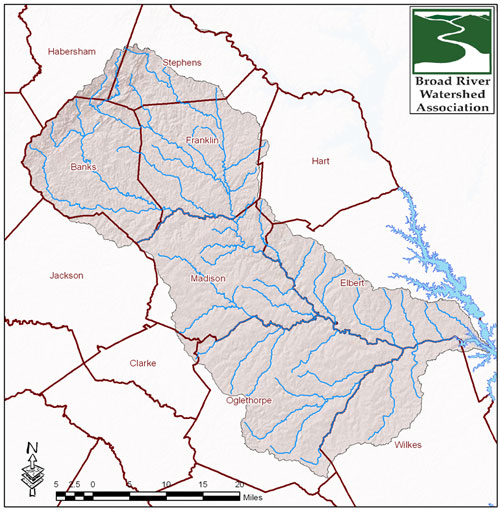
BRWA Mission
THE RIVER
The River
The Broad River is among the last free-flowing rivers in Georgia. It flows south from its headwaters in Banks and Stephens Counties through Madison and Elbert Counties to its confluence with the Savannah River at the Clarks Hill/Strom Thurmond Reservoir.
The Broad River is critical to the health and economic well-being of the citizens of northeast Georgia. It provides drinking water for the cities of Royston and Franklin Springs and it is an industrial and agricultural water supply for the region.
The river provides residents with an array of recreational activities including boating and fishing. The river supports a variety of fish including bass, catfish, and as of last year the robust redhorse. Currently public access to the river is quite limited.
The National Park Service recognized 99 miles of the Broad River as being pristine enough to qualify as part of the Federal Wild and Scenic Rivers System. In 1976, The Georgia Department of Natural Resources, recognizing its good environmental condition, proposed that the Broad River be designated an environmental corridor. Additionally, in 1993, the Georgia Department of Community Affairs designated the Broad River a Regionally Important Resource (RIR) initializing the development of a resource management strategy.
The Watershed
The Broad River Watershed is approximately 944,000 acres
and includes parts of thirteen counties:
- Banks
- Clarke
- Elbert
- Franklin
- Habersham
- Hart
- Hall
- Jackson
- Lincoln
- Madison
- Oglethorpe
- Stephens
- Wilkes

1Though parts of Lincoln and Hall Counties are technically in the watershed they are generally not included in the study area for watershed projects. Only a small sliver of Hall County (if that) drains into the Broad and the parts of Lincoln County that are in the watershed drain directly into Clarks Hill Reservoir. ( maps )
The northern portion of the watershed is confined by steep forested ridges. There is very little development in this area. The southern portion is flatter and agriculture extends into the flood plain. Sedimentation is high in this part of the river. Agriculture is the primary land use throughout the valley and includes some managed forestland. Industrial use in the watershed is limited to a few granite quarries.
The watershed remains in a largely natural state. Its position in the Piedmont with the Appalachians to the north and the coastal plain to the south allows for a highly diverse assemblage of plant and animal communities. It provides habitat for deer, turkeys, bobcats, foxes, beavers, otters, muskrats, quail, dove, mallards, wood ducks, turtles, crayfish and many others. Among the rare and endangered species that live in the watershed is the Shoal Lily (Hymenocallis occidentalis) which grows on rocks in and around the river.
The northern portion of the watershed is confined by steep forested ridges. There is very little development in this area. The southern portion is flatter and agriculture extends into the flood plain. Sedimentation is high in this part of the river. Agriculture is the primary land use throughout the valley and includes some managed forestland. Industrial use in the watershed is limited to a few granite quarries.
The watershed remains in a largely natural state. Its position in the Piedmont with the Appalachians to the north and the coastal plain to the south allows for a highly diverse assemblage of plant and animal communities. It provides habitat for deer, turkeys, bobcats, foxes, beavers, otters, muskrats, quail, dove, mallards, wood ducks, turtles, crayfish and many others. Among the rare and endangered species that live in the watershed is the Shoal Lily (Hymenocallis occidentalis) which grows on rocks in and around the river.
The Threat
The Broad River Watershed is in better condition than a lot of Piedmont rivers, but its threats are not taken lightly by its residents. Agricultural non-point source pollution, effluent from septic systems, landfill leachate, litter, construction in the floodplain, riverbank erosion, destruction of the vegetative buffer, lack of tributary protection, and poorly planned development all pose threats to the river. Additionally, lack of public access to the river encourages trespassing which contributes to the degradation of river banks and destruction of vegetation.
Counties within the Broad River Watershed are taking measures to protect it. Franklin County has adopted a special use permit ordinance to protect water quality. Elbert County has a 200 foot buffer along the River. Madison County is considering the adoption of a river overlay zone. Protecting the Broad River is also a major concern for the Northeast Georgia Regional Development Center.
In 1991, the Broad River Watershed Association was formed with protection of the Broad River as its mission. It is involved with the watershed’s residents and numerous public and private organizations in several conservation projects.